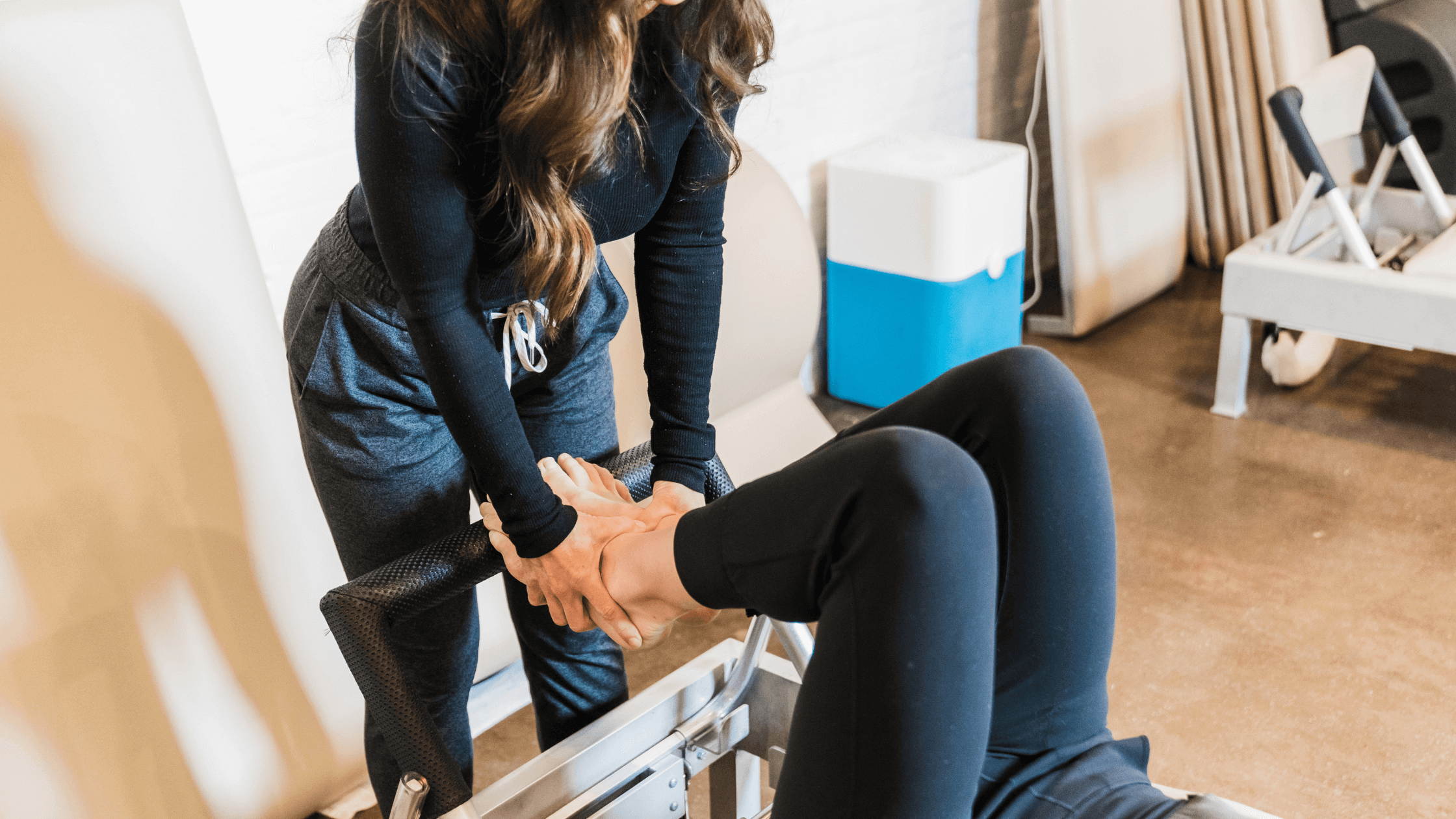Physical Therapy | Women's Health
Physical Therapy For Urinary Incontinence: Pelvic Floor Physical Therapy in Birmingham, Alabama

Physical Therapist, PT, DPT, MTC // EW Pilates Instructor // EW CoreAlign Instructor // Certified in Dry Needling // EW Motion Therapy Homewood
Some medical conditions are easier to talk about than others. Whether you have diabetes or osteoporosis, or mental health conditions like anxiety and depression, it can be helpful to seek comfort among a community of individuals who also struggle with your condition. On the other hand, some conditions are harder and more embarrassing to bring up in conversation. Most people would probably count incontinence as one of these.
The condition is widespread: over 60% of adult women in the United States report some degree of urinary incontinence, with a third of those having leakage at least once a month (Leslie, Tran, Puckett, 2024). Many people do not seek the help they need due to embarrassment about discussing their condition with someone, but it is vital to seek help to maintain the health of your pelvic floor.
Urinary incontinence can seem embarrassing, but just like any other medical condition, there are treatments that can help, including physical therapy. At EW Motion Therapy in Birmingham, Alabama, we encourage our pelvic floor physical therapy patients to be open and honest with us, so we can give them the most comprehensive treatment possible and help them move, feel, and live better.
This article discusses:
- General pelvic floor dysfunction
- Types of incontinence and their symptoms
- How physical therapy can help
- Your next steps
With this information, you can discuss your concerns with your doctor and ensure you are receiving the care you need to improve your quality of life.
What is pelvic floor dysfunction?
Incontinence itself falls under an umbrella diagnosis of pelvic floor dysfunction. Your pelvic floor is a complex network of muscles that supports your pelvis and lower abdominal organs; it contracts and relaxes depending on the function your body needs. When it does not work correctly, you can have issues with:
- Urinary urgency
- Low back pain
- Constipation
- Painful intercourse
- Many other conditions, including urinary and/or fecal incontinence
Most people assume pelvic floor dysfunction occurs only after pregnancy or childbirth. However, you can develop pelvic floor dysfunction following any abdominal/pelvic/hip/back surgery, trauma, and external stressors. We all carry stress in our bodies; some people, especially women, can carry stress in their pelvis, which can then cause issues in the pelvic floor.
Pelvic floor dysfunction is signaled by pain, tension, or weakness from lengthened muscles. Let’s discuss how urinary incontinence is related to a dysfunction of your pelvic floor.
The 4 types of urinary incontinence and symptoms
Incontinence is the opposite of continence, which is voluntary control of your bowels and bladder. This control requires:
- Mobility
- Sensation
- Intact functioning of the nervous system
In other words, it requires the bladder or bowels to expand and contract, which is accomplished by the pelvic floor muscles. Having a strong connection between the brain and the pelvic floor is crucial to this "rhythm" of everything working together to improve and maintain bladder control.
Within the diagnosis of urinary incontinence, there are four different types:
- Stress urinary incontinence is the involuntary loss of urine that occurs with physical exertion.
- If you leak a little when you sneeze, cough, laugh, or exercise, you may have this type.
- This is why many female weightlifters wear pads or panty liners while lifting to catch leaks.
- Urge urinary incontinence is also involuntary and happens when you feel a strong urge to urinate.
- If you leak on your way to the toilet or are triggered to urinate by specific actions you take during the day, you may have this type.
- A third type is overflow urinary incontinence, where you have leaking when your bladder gets too full.
- If you wet the bed at night or feel the urge to urinate even when your bladder is empty, you might have this third type.
- Many people have a mixture of all three types of incontinence, or mixed urinary incontinence.
You can probably relate to one of these types of urinary incontinence, right? So, if you think you are the only one suffering from incontinence, rest assured: you are not alone.
Physical therapy for urinary incontinence
While you could try medications or even surgery to help your urinary incontinence, physical therapy is an effective, non-invasive approach. A physical therapist can address behavioral changes appropriate to your specific needs to reduce unwanted leakage. They will use specific exercises to work on:
- Pelvic floor detraining
- Bladder retraining
- Pelvic floor muscle strengthening
- Improving mobility
They can also educate you on improving control of urgency and bladder coordination, as well as any other behavioral changes they believe would help alleviate your specific symptoms and triggers. For example, if you always feel the need to use the restroom when you get home from work, your physical therapist can help you work through that trigger and rewire your brain and pelvic floor to function better together.
6 essential behaviors and 4 home exercises to help with incontinence
In addition to physical therapy, you can practice certain behaviors on your own to improve your continence. Here are six key ones:
- Avoid hovering or squatting over the toilet.
- Do not strain or push your urine.
- Avoid habitual holding.
- Avoid “just in case” voiding.
- Intake healthy fluids.
- Incorporate non-irritating foods into your diet, like pears, apricots, and non-citrus herbal teas.
Along with specific pelvic floor exercises that your physical therapist would give you, like Kegels, some other exercises you can work on at home include:
- Core strengthening, such as pelvic clocks or pelvic tilts
- Glute strengthening, like bridges
- Relaxation techniques
- Belly breathing
Your pelvic floor is more than just a group of muscles that help you maintain continence: it's part of a unified system that includes your core, glutes, and back muscles all working together to support your pelvis and provide stability throughout your body. It is vital to maintain the health of your pelvic floor so you can move and perform efficiently during your day.
What to do next: pelvic floor physical therapy in Birmingham, Alabama
It can feel embarrassing to talk about incontinence, but when you are honest with your healthcare professionals of choice, they can help you find the best solutions. At EW Motion Therapy in Birmingham, Alabama, we create a safe space for our patients where they can be honest about their symptoms and provide us with the information we need to create a care plan tailored to their needs. We accept referrals from gynecologists, urologists, and urogynecologists throughout the Birmingham area. Whether your provider is at Grandview, UAB Hospital, St. Vincent’s, or a private practice, we collaborate with them to make sure you receive the best treatment for your condition.
If you are interested in physical therapy for your pelvic floor, click here to download our top 20 frequently asked women’s health questions. Then, reach out to us to speak with a specialist who can address your concerns and guide you in the best direction for your pelvic floor health.
References
Leslie SW, Tran LN, Puckett Y. Urinary Incontinence. [Updated 2024 Aug 11]. In: StatPearls [Internet]. Treasure Island (FL): StatPearls Publishing; 2025 Jan-. Available from: https://www.ncbi.nlm.nih.gov/books/NBK559095/

